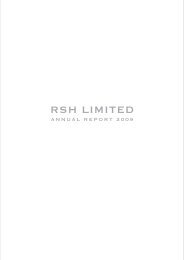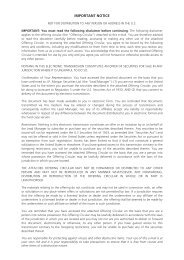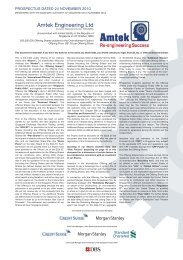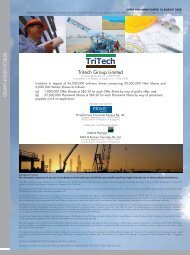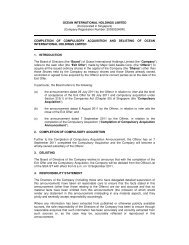O TTO M ARINE L IMITED - Microsoft Internet Explorer - SGX
O TTO M ARINE L IMITED - Microsoft Internet Explorer - SGX
O TTO M ARINE L IMITED - Microsoft Internet Explorer - SGX
Create successful ePaper yourself
Turn your PDF publications into a flip-book with our unique Google optimized e-Paper software.
INDUSTRY OVERVIEW<br />
This section is provided by Braemar Seascope Offshore (“Seascope”). The statistical and graphical<br />
information contained herein is drawn from Seascope’s database and other sources. Graphs and tables are all<br />
prepared from information contained in Seascopes own data bases unless an alternative source is indicated<br />
underneath the relevant graph or table. In connection therewith, Seascope has advised that: (i) certain<br />
information in its’ database is derived from estimates or subjective judgments; (ii) the information in the<br />
databases of other maritime data collection agencies may differ from the information in Seascope’s database;<br />
(iii) whilst Seascope has taken reasonable care in the compilation of the statistical and graphical information<br />
and believes it to be accurate and correct, data compilation is subject to limited audit and validation<br />
procedures and may accordingly contain errors.<br />
Seascope further advise that you should also be aware that since 1 September 2008, (the date of<br />
Seascope’s general overview), there may have been changes in the shipping industry and the various sectors<br />
therein which could affect the accuracy or completeness of the information in this section.<br />
1.0 Introduction<br />
The World Energy Outlook 2007 report released by the International Energy Agency (IEA) forecasts that<br />
the global primary energy demand will increase at an average annual rate of 1.8% between 2005 and 2030,<br />
with global oil demand reaching 116 million barrels per day in 2030, an increase of 37% up on 2006. More<br />
than 70% of this increase comes from developing countries.<br />
World Energy Outlook 2007 projected that two-thirds of the increment would be used in the transportation<br />
sector, where petroleum remains to be widely used since there are few competitive alternatives at present.<br />
Less than one-third of the projected increase would be from the industrial sector, which is mainly used in<br />
chemical and petrochemical processes. Much of the overall increase in consumption was anticipated to come<br />
from nations where strong economic growth is expected, especially in Asia.<br />
The latest report by the BP Statistical Review of World Energy June 2008 cites that two-thirds of global<br />
energy consumption growth was from the Asia-Pacific region. Even though Chinese growth of 7.7% was the<br />
weakest since 2002, China is accountable for half the global energy consumption growth, ahead of the US and<br />
India.<br />
Demand for oil and gas is dependent on a variety of factors, one of which is the winter weather. Since a<br />
great proportion of energy is used for heating homes, there will be less demand and thus a decline in energy<br />
prices during mild winters. Population growth, robust economic growth and the resulting burgeoning industrial<br />
activity as exhibited particularly by China and India, and rapidly expanding transportation especially in recent<br />
years of low-cost airlines are also responsible for increased demand for energy and subsequently higher prices.<br />
Political developments which are adversely affecting production in oil rich nations such as Iran, Iraq and<br />
more recently Nigeria, are also responsible for the shortage of supply and thus a higher price. Graph 1<br />
illustrates that the price of crude oil is directly correlated to world events, where the price of crude oil is<br />
higher than normal during periods of political unrest (reflected in the spikes of oil prices). Supply shortages,<br />
for example caused by hurricanes, as well as low levels of oil and gas inventories also result in higher prices.<br />
In recent years however, some of the early discovered economically viable oil and gas fields are maturing<br />
and/or are close to being exhausted. Even with EOR (Enhanced Oil Recovery) technology to increase the<br />
amount of oil which can be extracted from an oil field, the substantial costs involved for this process offsets<br />
the profits and revenues are dependent on prevailing oil prices. The North Sea is a good example of an area<br />
where the production is in decline because of exhaustion as well as for geological reasons and this declining<br />
trend does not seem to be reversible despite EOR and the current high oil price. This has led to the increase of<br />
deep sea exploration activities and the subsequent demand for offshore vessels in order to meet the worldwide<br />
demand for oil and gas.<br />
Offshore oil and gas exploration is taking place in many geographic areas of the world and well over<br />
95% of all cargo going to offshore drilling units and platforms is transported by vessel. The range of offshore<br />
support vessels is therefore diverse in size and function, with more than 20 types of specifically designed<br />
vessels that comprised a total of about 5,691 vessels in the entire worldwide fleet in January 2008.<br />
Transportation services of cargo and supplies to offshore drilling rigs, fixed and floating platforms is the main<br />
workscope but other services include transport of personnel to, from and between offshore installations, towing<br />
rigs to location and placing or retrieving their anchors, providing safety and emergency response services, and<br />
supporting offshore construction projects. This latter workscope covers a multitude of different vessels<br />
73



